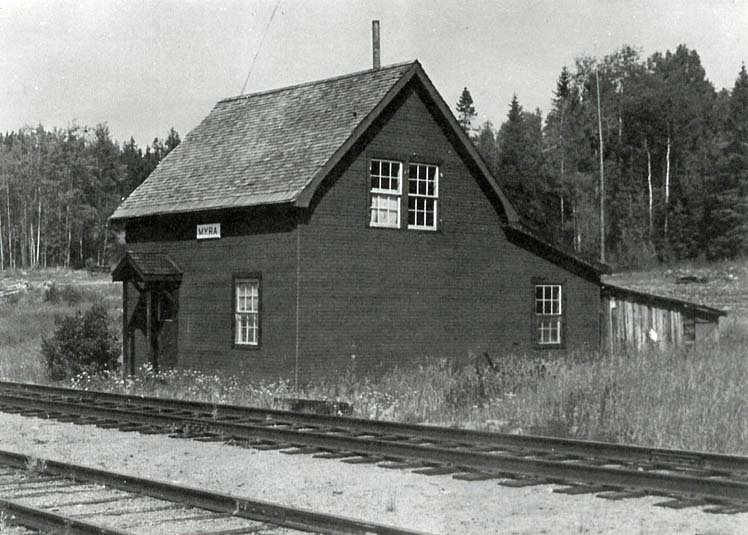
with a Little History
Myra Canyon British Columbia - Here's an update on the Myra Canyon Trestle Restoration Society (MCTRS) with a little history
first.
The Sheriff first visited the Myra Canyon section of the former Kettle Valley Railway (KVR) in 1980 when the steel rails were still in place and a Kelowna
society was trying to raise enough money to buy them, keep the rail line intact, and potentially operate a tourist train.
The Sheriff was one of the last people to ride through the canyon on a "railway speeder" (also known as railway motor car, putt-putt,
track-maintenance car) and he thought, as its wheels went click, click, click over the rail junctions that this is the way the canyon was meant to be
seen.
When that rescue effort failed, the rails were removed and it became a popular, but un-maintained recreation trail.
Until two women cycling flipped off trestles and died.
And then, the new MCTRS stepped in to deck the 18 trestles and install handrails.
The Sheriff has to admit he had tears in his eyes with word the 2003 Okanagan Mountain wildfire destroyed or damaged most of the trestles.
In June 2008, he played the part of Sir Thomas Shaughnessy, former president of the Canadian Pacific Railway (CP), the man responsible for the construction of
the KVR, at the official re-opening of what the Sheriff believes is the Okanagan Valley's top attraction, an incredible combination of man-made wonder and
natural beauty.
The society has not stopped since then and celebrates its 25th anniversary this year with a $200,000 fund raising campaign.
The annual general meeting will be held at 19:00 on Wednesday in the EECO Centre in Mission Creek Regional Park on Springfield Road in Kelowna.
Attendees will hear about 2017 projects and 2018 plans including the 2018 fund raising campaign and the proposed opening of the original Morrissey construction
work camp for public viewing.
To find out more, the Sheriff interviewed society director Ray Sobol.
"Last year, we weren't able to get some things done, in particular work on the two work camps, the Morrissey and the Huissi camps, that are still on our
menu," he said.
The Morrissey camp is located off the Ruth Station parking lot at the Little White forest service road (June Springs Road) end of the canyon.
When Sobol researched the history, he found E.A. Morrissey's Camp No. 2 was one of seven camps in the Myra Canyon area.
Others included Huissi's Camp and George Chew's Camps 9 through 12.
Camps were named after the relevant railway contractor so this one was named after E.A. Morrissey, a railway contractor from Spokane, Washington, who worked as
a sub-contractor to Grant Smith & Company, the general contractor for the Midway to Penticton section of the KVR.
Among other accomplishments, Morrissey completed the last mile of CP into the City of Vancouver.
For his work, Morrissey was paid $177,012 of the $2,367,451 paid to all the sub-contractors.
The camp was likely established in September or October 1912, and closed down for a time in December 1913.
It re-opened in the spring of 1914.
It generally housed 70-90 men although after March 1914, the numbers were reduced significantly.
Many of the men were Italians known for their mortarless stonework as evidenced by the two ovens used extensively to bake loaves of bread 60 centimetres long
and 20 centimetres high.
The men, who needed between 5,000 and 6,000 calories per day, ate half a loaf each day.
The men at this camp moved about 67,000 cubic yards of solid rock and nearly 16,000 cubic yards of loose material, working through all the seasons regardless
of rain or snow, clear or cloudy skies.
Like other railway contractors, Morrissey had difficulty finding enough men to work his section.
George Buck, the KVR engineer responsible for the section where Morrissey worked, reported that the men "came and went" from Morrissey's
camps.
Sometimes they left the camp the same day they arrived.
The society hopes to start working on the Huissi Camp, about a kilometre from the rail line further south, in 2019.
There isn't as much brush to clear to get in there.
For the Morrissey camp, volunteers will build a relatively easy walking trail of a couple hundred metres to meet BC Parks' standards and then clean up the site
by removing brush and trees.
Safety barriers will be erected around the two rock ovens and a well, interpretive signs installed there, and around rock foundations left after wildfires
destroyed the buildings.
Sobol, who does the work schedules, estimates it will probably take five volunteers spending 50-60 hours each for a total of 250-300 hours.
"Close to 10 years ago, we had students from UBC Okanagan come in and do some archeological digs. Some of these would have been for tents, some log
cabins, where horses were kept, that kind of thing. What we should be able to show is what was the way of life at that time, at that particular spot. There's
old photos that can be displayed," said Sobol. You have to be pretty rugged to do that kind of work. When you got paid on Friday nights, people walked 15
kilometres as the crow flies into town and back. At that time, there wasn't much in the way of roads, just bits of trails, and I would hazard a guess, running
into the occasional bear."
This year, the society also hopes to install another pit toilet by storm shelter No. 2 near trestle No. 11, subject to inspection.
Society volunteers undertake numerous activities, such as construction and maintenance of storm shelters and memorial benches, clearing of fallen rocks, trees,
and mud slides, repairs to trestle decking and railings, improvements to the paths, and protection of historic artifacts.
This work is carried out under a Partnership Agreement with B.C. Parks, which runs through 2024.
The society is seeking volunteers to assist in construction and other activities, and to serve on the board of directors.
The public is welcome to attend the AGM, however, only members can vote.
A membership is $10 a year and may be purchased just prior to the meeting or from the website
www.myraTrestles.com.
The society last raised funds prior to 2008.
Since then, it has operated with an annual average budget of $30,000, the result of donations received (with no public plea) after the 2003
wildfire.
Those donations support the trail host program, annual maintenance, materials, tools, equipment, kiosks, insurance, vehicles, and transportation, legal and
other expenses.
There are no paid positions.
All work is done by volunteers unless specialized work is required.
"Since the society was formed 25 years ago, conservatively, we estimate 40,000 man-hours were donated by volunteers," said Sobol.
J.P. Squire.
provisions in Section 29 of the Canadian
Copyright Modernization Act.


